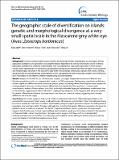Por favor, use este identificador para citar o enlazar a este item:
http://hdl.handle.net/10261/33669COMPARTIR / EXPORTAR:
 SHARE SHARE
 CORE
BASE CORE
BASE
|
|
| Visualizar otros formatos: MARC | Dublin Core | RDF | ORE | MODS | METS | DIDL | DATACITE | |

| Título: | The geographic scale of diversification on islands: genetic and morphological divergence at a very small spatial scale in the Mascarene grey white-eye (Aves: Zosterops borbonicus) |
Autor: | Milá, Borja CSIC ORCID | Fecha de publicación: | 26-may-2010 | Editor: | BioMed Central | Citación: | BMC Evolutionary Biology 10: 158 (2010) | Resumen: | [Background]: Oceanic islands provide unique scenarios for studying the roles of geography and ecology in driving population divergence and speciation. Assessing the relative importance of selective and neutral factors in driving population divergence is central to understanding how such divergence may lead to speciation in small oceanic islands, where opportunities for gene flow and population mixing are potentially high. Here we report a case of genetic and morphological structure in the Mascarene grey white-eye (Zosterops borbonicus) a species that shows a striking, geographically structured plumage polymorphism on the topographically and ecologically complex island of Réunion, yet is monotypic on the relatively uniform neighbouring island of Mauritius. [Results]: Analysis of 276 AFLP loci in 197 individuals revealed prolonged independent evolution of Réunion and Mauritius populations, which is congruent with previous mtDNA assessments. Furthermore, populations on Réunion showed significant differentiation into three main genetic groups separating lowland from highland areas despite the small geographic distances involved. Genetic differentiation along the altitudinal gradient is consistent with morphometric analysis of fitness-related traits. Birds in the highlands were larger, yet had relatively smaller beaks than in the lowlands, suggesting the role of selection in shaping morphology and restricting gene flow along the gradient. No genetic differentiation between plumage morphs was detected in neutral markers, suggesting that plumage differences are of recent origin. [Conclusions]: Our results suggest a dual role of vicariance and natural selection in differentiating populations of a passerine bird in an oceanic island at very small spatial scales. We propose a combination of past microallopatry driven by volcanic activity and selection-constrained dispersal along steep ecological gradients to explain the striking levels of population structure found within the island, although the possibility that genetic differences evolved in situ along the gradient cannot be ruled out at present. The lack of congruence between genetic groups and plumage morphs suggests that the latter are of recent origin and likely due to social or sexual selection acting on few loci. The presence of sharp and stable contact zones between plumage morphs suggests that they could be on independent evolutionary trajectories, yet whether or not they represent incipient species will require further research to directly assess the degree of reproductive isolation among them. | Descripción: | 13 páginas, 6 figuras, 6 tablas.-- et al. | Versión del editor: | http://dx.doi.org/10.1186/1471-2148-10-158 | URI: | http://hdl.handle.net/10261/33669 | DOI: | 10.1186/1471-2148-10-158 | ISSN: | 1471-2148 |
| Aparece en las colecciones: | (MNCN) Artículos |
Ficheros en este ítem:
| Fichero | Descripción | Tamaño | Formato | |
|---|---|---|---|---|
| 1471-2148-10-158.pdf | 1,22 MB | Adobe PDF |  Visualizar/Abrir |
CORE Recommender
PubMed Central
Citations
23
checked on 17-abr-2024
SCOPUSTM
Citations
72
checked on 15-abr-2024
WEB OF SCIENCETM
Citations
72
checked on 28-feb-2024
Page view(s)
346
checked on 19-abr-2024
Download(s)
226
checked on 19-abr-2024
Google ScholarTM
Check
Altmetric
Altmetric
Artículos relacionados:
NOTA: Los ítems de Digital.CSIC están protegidos por copyright, con todos los derechos reservados, a menos que se indique lo contrario.
